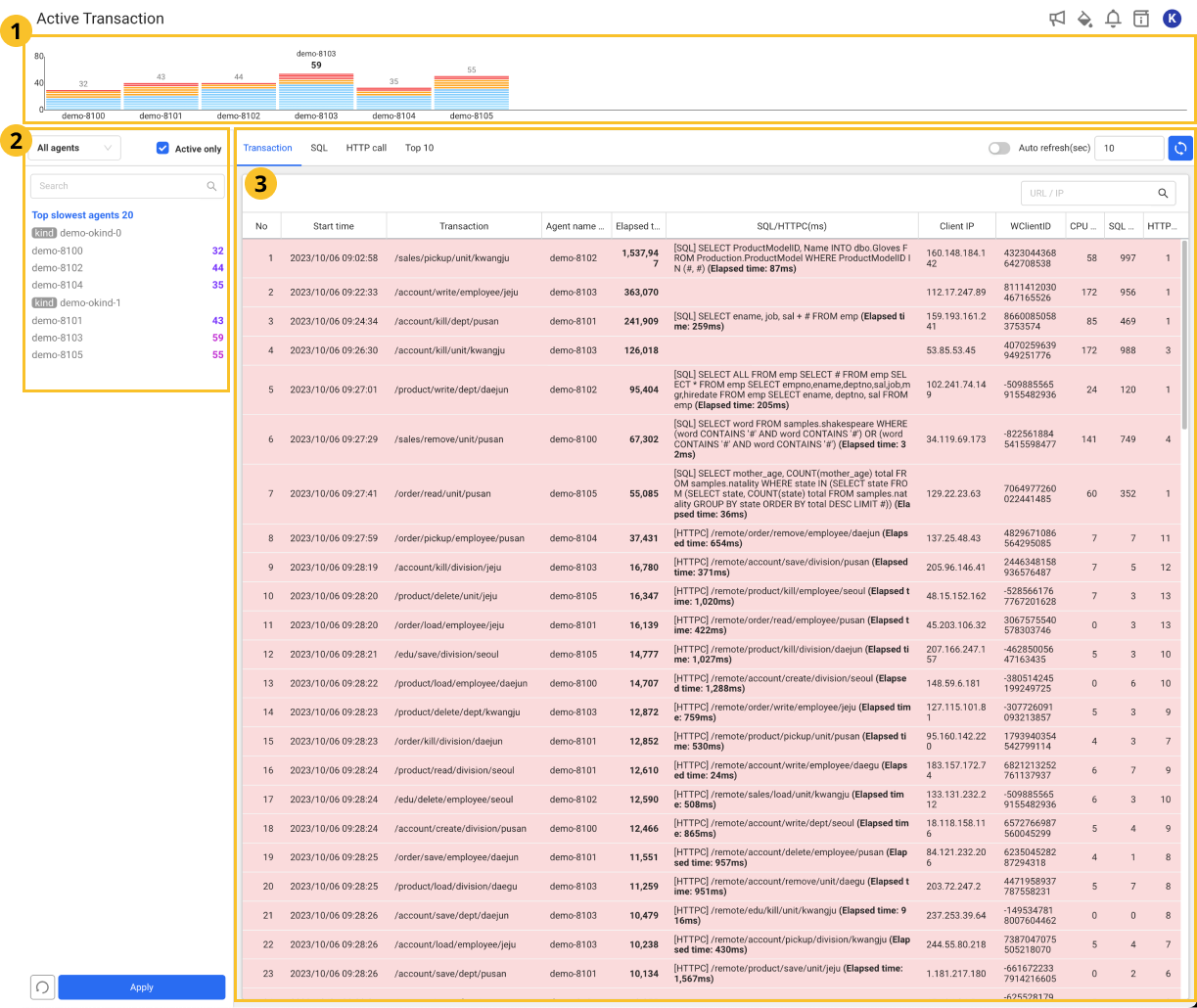Active Transaction
Home > Select Project > Dashboard > Active Transaction
You can quickly recognize abnormal transactions by using URLs, SQLs, and HTTP calls of the active transactions, and can analyze the delayed sections in detail through the transaction trace details.
By adding a database project via the Correlated Project Management menu, you can view the SQL performance of the database linked to the current transaction. For more information about the Correlated Project Management menu and linked project analysis, see the following.
Screen layout

Active transactions for each agent
It displays a list of all application servers and the total number of active transactions. Hover your mouse over each graph on the chart to display the transaction speed. The speed of the transaction state is classified into Normal, Slow, and Very Slow.
Agent List
It displays the application server list and the total number of active transactions. If you select the application server, In the transaction list, the detailed information appears.
Transaction List
It displays the detailed information of active transactions including URLs, SQLs, and HTTP calls. If you select the Top 10 Items tab, you can see a table of items sorted by the elapsed time in the ascending order. Likewise, the speeds of the transaction state are classified into Normal, Slow, and Very Slow.
When you select an item in the transaction list, the Active transaction window appears where you can see the details on the selected transaction.

-
You can see detailed information of the running transactions, external calls, queries, call stacks, and the like.
-
Refresh all: You can update information of the running transactions.
-
Stop thread: You can stop a transaction in progress. To stop threading, Secret key is required. For more information about Secret key, see the following.
-
Correlated DB session: You can query the SQL performance of the database linked to the active transaction. It appears only when the selected transaction is the one that executed SQL as a linked project. For more information about addition and management of the linked projects, see the following.
TipStop thread forcibly stops threads running in the application. However, this feature may not work in all cases. For example, if a thread performs an IO operation, the thread cannot be stopped immediately.
Stop thread attempts to terminate the thread even if it is performing an IO operation. However, the thread does not stop until it finishes its IO operation. The thread accepts the termination request, but it does not stop until its operation is completed and it goes to the next work.
In this case, forcible termination is not recommended because it may cause problems with business logic and cause unexpected operations. If you need to stop the thread, stop and restart the entire application.
-
-
If a transaction has already ended, the Show trace button appears. When you select the button, the Transaction information window appears. For more information about Transaction information, see the following.
Agent list filtering
In Agent List, you can select or search the filtering targets and see them individually in the transaction list.
-
To see the active agents, select the Active only checkbox.
-
Click the All agents list box. You can view the agents by category.
-
To see active transactions by agent, select an agent and then click Apply. To cancel the selection, select
.
Automatic refresh
The active transactions can be automatically updated at the set intervals. Select Auto refresh(sec) to activate the option, and then enter the refresh interval in the field on the right.
To deactivate the auto refresh setting, select Auto refresh(sec) again.
- The time is updated in seconds.
- To update the transaction list when the auto refresh is deactivated, select
.
Transaction list filtering
In Transaction List, you can search for URL or IP for filtering. Enter a filtering target in the URL/IP field on the upper right and then press Enter or select
. It filters with the transaction list that includes the input text.
To initialize the filtered list, delete text in the URL/IP field on the upper right, and then press Enter or select .
For more information about active transaction settings, see the following.